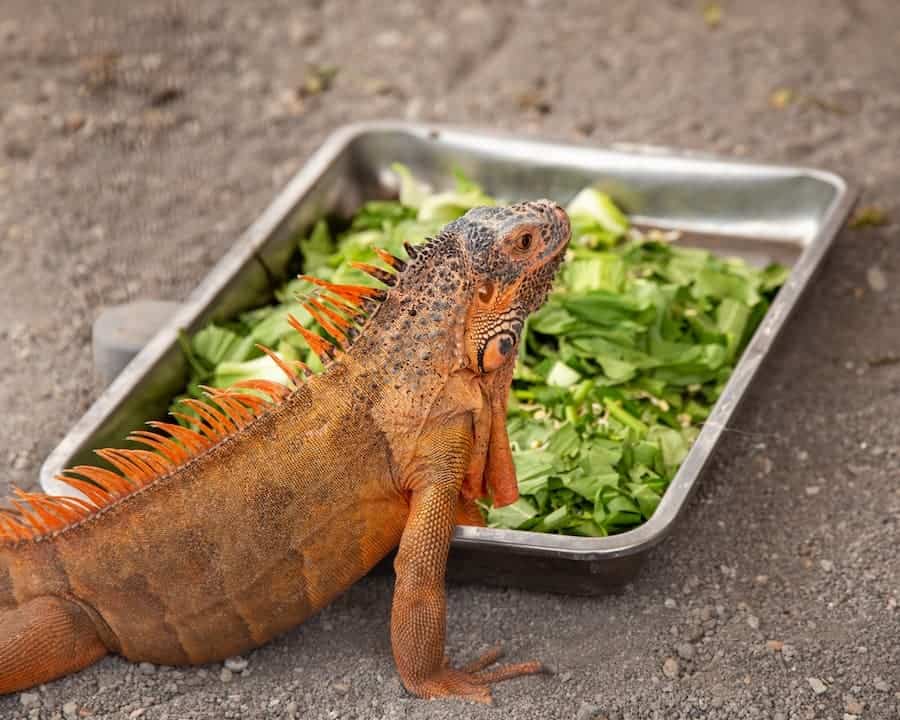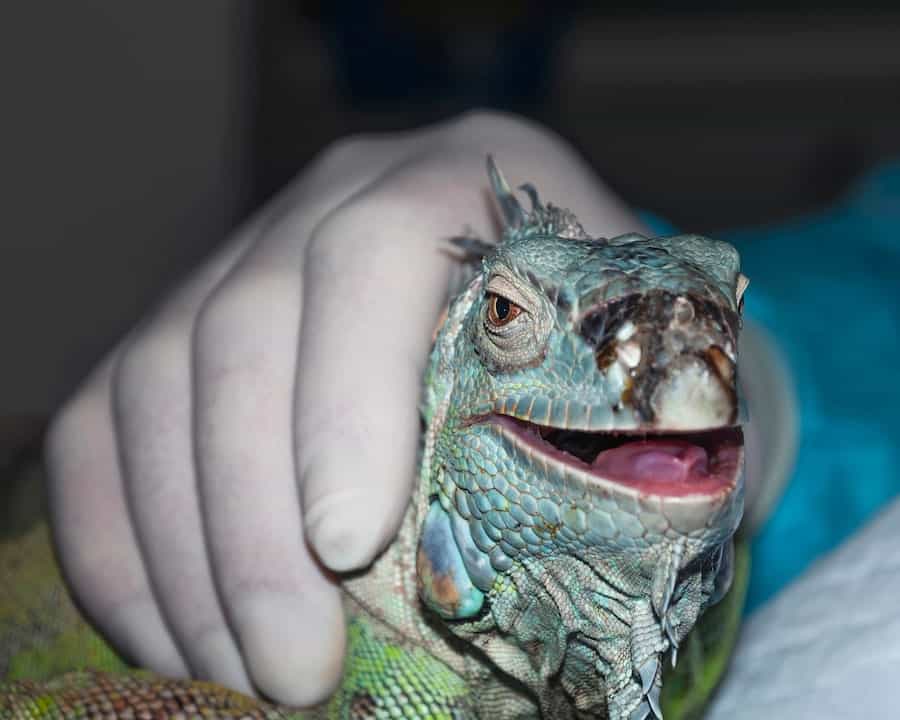Is something wrong with your iguana, or is he shedding his skin?
Iguanas shed more frequently as juveniles and less often as they begin to reach full maturity. Healthy iguanas will shed to accommodate their new body size and to expel parasites. Irregular shedding can be a sign of illness.
I’m going to answer the most common questions people have about their iguana’s shedding to provide some insight into this topic.
Do Iguanas Shed?
Yes. Iguanas shed just like most reptiles.
Why do Iguanas Shed?

We’ve established that iguanas do shed, but why do they shed? Iguanas continue to grow for up to eight years, and while their body grows, their skin will stop growing.
The skin’s outer layer will grow, causing a new layer of skin to fit the iguana and expel the second skin layer.
Shedding can also be beneficial for your reptile, allowing your iguana to:
- Remove harmful parasites found on the skin
- Grow into their new layer of skin
So, if you own an iguana, there’s no concern that they’re shedding unless it’s an abnormal shedding that is occurring too often.
Have you ever wondered how big iguanas get? I just wrote a detailed article on this subject, titled How Big do Iguanas Get? Size Chart by Age & Breeds Included.
How Often do Iguanas Shed?

Iguanas will shed a lot when they’re juveniles and less often as they reach their full maturity. Generally, an average iguana will shed according to the following schedule:
- Babies will shed every 4 – 6 weeks
- Adults will shed 1 – 2 times per year
During the initial years of an iguana’s life, they’ll shed up to two times annually because they tend to grow at a rapid rate. After all, most iguanas will reach 6 – 6.5 feet in length, and this takes years to occur.
You can expect your adult iguana to stop shedding as they reach ages 6 – 8, when they’re starting to reach their maximum size.
Many owners find that their green iguana starts shedding different parts of its body at different times. Owners should never be concerned about their iguana shedding because it’s a sign of a healthy iguana.
Routinely taking your iguana to the veterinarian will allow you to monitor your iguana and ensure he is shedding at a normal rate.
Iguana Behavior While Shedding
Iguana behavior is a major talking point on iguana owner forums because these fun reptiles can also be very moody at times. However, there is also a lot of talk about iguana behavior when they begin shedding.
In his book, “Green Iguana The Ultimate Owner’s Manual,” author James W. Hatfield notes that most iguanas do not exhibit any behavioral changes when they shed.
Most is the key word here. There are a few behaviors that owners do mention when they notice their pets shedding:
Iguanas May Not Eat While Shedding

In some rare cases, your iguana may not eat as much while shedding. Typically, the main reason that your iguana will have issues eating during a shed is because they’re having difficulty shedding.
Since iguanas will shed through many periods of their lives, not eating can quickly lead to a health scare.
While your iguana may have a slightly lower appetite when shedding, the issue shouldn’t last more than a day or two. Otherwise, your reptile may not be eating for another reason that you’re overlooking.
Iguana Rubbing

Iguanas tend to shed with greater ease as they age, but when shedding is a struggle, your iguana may begin rubbing on surfaces. The rubbing is meant to:
- Loosen the skin
- Remove the old skin
Moody Iguana

Some iguana owners find that their reptile gets moody when they’re shedding. While the right conditions and help can ease a difficult shed, it’s not uncommon for your iguana to have mood swings when shedding.
Shedding is just one of many reasons why an iguana may not eat. I recently wrote a post titled Top 15 Reasons Why Your Iguana is Not Eating that will shed some light on why your pet has lost its appetite. Pun intended.
Do Iguanas Shed at a Certain Time of The Year?
No. Iguanas can shed on their own schedule, but it’s an erratic schedule at best. Your iguana may shed in March of this year and never shed in March again in their lifetime.
What to do When Your Iguana is Shedding (3 Tips)
1. Mist and Soak

Iguana’s love a good mist and soak, and they’ll appreciate the mist and soak more when they’re shedding. The practice will keep the skin hydrated and can assist with removing any skin that is still stuck on your iguana.
When soaking, keep the water rather warm, but not scalding.
A dip in a 90 – 95° bath will help your lizard shed and feel much better if they’re struggling to shed. You can also use a shedding aid to help.
2. Apply Shedding Aid
A shedding aid can help your reptile shed with greater ease. You’ll find a lot of options available, but one of the most popular ones is called “Zoo Med Repti Shedding Aid.”
The aid will work to moisturize your iguana’s skin, remove dried sheds and will even work between sheds.
3. Add Rubbing Objects

Make sure that your iguana has objects to rub on during the shedding phase. Climbing branches and rough rocks can help your pet shed its skin safely and comfortably.
Rough surfaces can be helpful, but make sure that there are no sharp edges that can injure your iguana.
Signs of Unhealthy Shedding

As an iguana prepares for its shedding phase, its color will become dull and dim. You’ll notice gray patches of skin starting to develop at the head and hands.
Sometimes, shedding doesn’t go as smoothly as planned. Abnormal shedding is a common problem in reptiles, and it’s known as disecdysis.
Signs of incomplete or unhealthy shedding include:
- Pieces of old skin remaining attached to the tail, toes and surface of the eyes.
- Bands of unshed skin that constrict tissue, which can lead to tissue death. Some iguanas may lose their toes or parts of their tail because of this constriction.
- Infections that develop under the patches of unshed skin. These areas will be red and irritated and may even drain pus.
Low humidity is the most common cause of unhealthy shedding in iguanas and other reptiles. Other causes can include:
- Not having any surfaces to rub on
- Parasites
- Poor diet
- Poor overall health
If issues with unshed skin are not resolved, it can lead to infection and other serious complications.
A good soak in a warm bath will often do the trick for removing stuck shed, but if this does not solve the problem, a trip to the vet is in order.
Do Iguanas Eat Their Shedded Skin?

Iguanas have all kinds of strange habits, but is eating their shedded skin one of them? It can be. Some iguanas do, in fact, eat parts of their shedded skin.
You’ll find many iguana owners talking about this phenomenon on reptile forums. It’s nothing to be concerned about unless your pet is exhibiting other concerning symptoms.
If you’re worried about your pet eating its shedded skin, consult with your vet.
Iguanas often eat items that non-owners never know about. Are you curious about what they eat? Read through a guide I recently wrote, titled “What Do Iguanas Eat?”
Should You Help an Iguana Shed
In a perfect world, your iguana would shed its skin without any issues. And if your temperature and humidity levels are correct, you probably won’t need to help your pet with this process.
But sometimes, with your best efforts and the right environmental conditions, some iguanas struggle with shedding. Should you help?
The answer is: it depends.
If your pet is having trouble shedding, there are a few things you can do to move things along:
- Soak and mist your iguana regularly. A long bath and regular misting will ensure there’s enough moisture to make shedding quicker and easier.
- Make sure your pet has objects to run against. Your enclosure should have a climbing branch of some sort, and your iguana can use this branch to help with his shedding.
One area that you may want to help with physically is the mouth.

Many iguanas will try rubbing their mouths on the cage to help with shedding. This behavior can cause thrush and ultimately lead to an infection.
As a general rule of thumb, you want to avoid trying to pull your iguana’s shedding skin. Remember that your pet will naturally shed its skin when it’s ready by rubbing against objects.
Trying to rush the shedding process and removing skin before its ready can injure your iguana or put its life at risk. Never forcefully remove any shedding skin by hand.
Iguanas also shed their spikes, and this is another process that you can help with. If spikes aren’t shed completely, growth may be constricted, and the tissue may die.
You can help your iguana shed its spikes by:
- Spraying the base of the spike with water to loosen the skin
- Working them gently over the course of several days
Applying pure coconut or mineral oil to the spike can also help with shedding.
If your iguana is having trouble shedding and is starting to experience build-up from stuck shedding, it’s time to call a vet and check the humidity levels of your enclosure.
Is Shedding Painful for Iguanas?

When an iguana’s enclosure is at the right temperature and humidity level, shedding should be a relatively straightforward process.
Iguanas may experience some irritation or itchiness, but generally, shedding should not be painful.
But if humidity levels are too low, shedding can become a painful and difficult process.
Final Thoughts
Shedding is a natural process for every iguana. Ensuring that your pet’s enclosure is at the right temperature and humidity level can help make this somewhat uncomfortable process a little easier.

